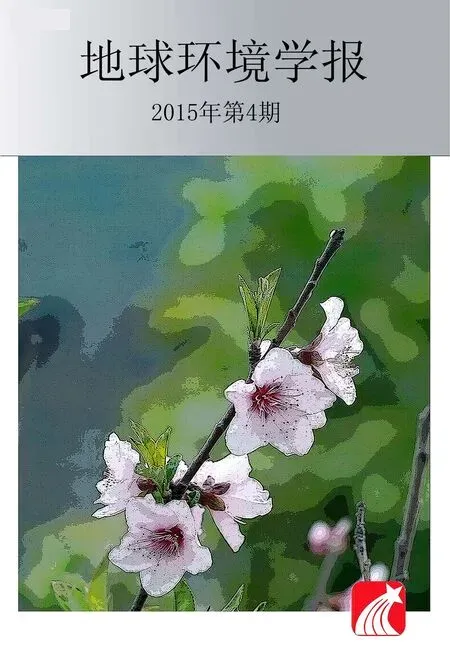城市地区PM2.5周末效应的初步研究
李建东,铁学熙,曹军骥
(1.中国科学院地球环境研究所 中科院气溶胶化学与物理重点实验室,西安 710061;
2.中国科学院大学,北京 100049;
3.National Center for Atmospheric Research,Boulder,CO 80303,USA;
4.西安交通大学 全球环境变化研究院,西安710049)
doi:10.7515/JEE201504004
城市地区PM2.5周末效应的初步研究
李建东1,2,铁学熙1,3,曹军骥1,4
(1.中国科学院地球环境研究所 中科院气溶胶化学与物理重点实验室,西安 710061;
2.中国科学院大学,北京 100049;
3.National Center for Atmospheric Research,Boulder,CO 80303,USA;
4.西安交通大学 全球环境变化研究院,西安710049)
本文利用2014年全国78个城市497个环境监测站的实时观测数据,分析了2014年颗粒物(PM2.5和PM10)和污染气体(包括SO2、NO2、CO和O3)的分布特征并初步探讨了城市地区周末与工作日PM2.5浓度的变化规律。2014年78个城市PM2.5年均浓度值为71.9μg·m-3,华北地区PM2.5年均浓度值在80~120μg·m-3,长三角地区PM2.5的年均值在40~60μg·m-3。污染气体相对于颗粒物更多的受到当地排放的影响。发现典型城市地区如北京、上海、广州、成都和西安等存在周末污染物浓度比工作日低的“PM2.5周末效应”,其中北京的周末效应最明显,对北京的周末效应进行初步分析发现周末与工作日机动车排放的变化是导致北京周末效应的主要原因。
污染气体;PM2.5;周末效应
随着城市化和经济的快速发展,中国面临着严重的颗粒物污染问题,特别是在京津冀、长三角和珠三角地区(van Donkelaar et al,2010)。很多观测表明北京PM2.5年均值超过了100μg·m-3,上海PM2.5年均值超过了60μg·m-3,均远远超过了世界卫生组织推荐安全值(10μg·m-3)。长时间暴露在高浓度的颗粒物污染下会对人体健康产生严重的影响(Dockery et al,1993;Dockery,2001;Ostro et al,2006;Franklin et al,2007;Ito et al,2011;Fann et al,2012;Correia et al,2013)。全球疾病负担评估报告显示2010年全球有320万人死于空气污染,其中中国居民占到了120万。作为主要大气污染物的二氧化硫(SO2),二氧化氮(NO2)、近地层臭氧(O3)、细颗粒物(PM2.5)已对生态环境和人体健康产生显著影响。
大气污染物存在着明显的周变化,这种周内的浓度变化与每天人类活动不同导致的排放差别有关。在城市地区,由于周末人类活动的减少会导致排放降低,NOx(NO和NO2)、CO、PM10、PM2.5和VOCs的浓度也会随之降低。周末效应指的是污染物浓度在周末和工作日有显著的变化(升高或降低)。大气污染物的周末效应引起了广泛的关注,美国(Blanchard and Tanenbaum,2003;Pun et al,2003;Murphy et al,2007;Koo et al,2012),欧洲(Pont and Fontan,2001;Jenkin et al,2002;Paschalidou and Kassomenos,2004),亚洲(Debaje and Kakade,2006;Pudasainee et al,2010;Srimuruganandam and Nagendra,2011)都有关于周末效应的研究,其中许多研究分析了气象参数,如温度和辐射的周末效应。 除此之外,也有研究针对周末效应现象进行了长时间尺度的分析(Fujita et al,2003)。化学传输模式也被用来在不同的排放情景下,研究城市和下风向地区周末效应的发生机制和强度。一般情况下对周末效应的解释都是针对研究目标前体物的减排,因此,对PM2.5周末效应的研究可以为PM2.5污染的控制提供独特的视角。同时,对周末效应的清楚认识可以使模式在不同的排放情景下更好地模拟出污染特征的变化(Koo et al,2012)。本次研究基于2014年全国78城市颗粒物和污染气体的小时浓度数据,对PM2.5的周末效应进行了初步研究,以期为PM2.5的时空变化特征及其来源解析研究提供参考。
1 数据与方法
2012年环保部批准发布了《环境空气质量标准》(GB 3095—2012),PM2.5首次纳入环境空气质量新的标准,一级和二级年均标准分别为35μg·m-3和75μg·m-3,24小时平均值标准为50μg·m-3,PM10的24小时均值标准为 150μg·m-3(国家环境保护部,2012a)。2012年三月,环保部开始公布环境空气质量指数AQI(air quality index),AQI由七种污染物(包括SO2、NO2、PM2.5、PM10、CO、1小时最大O3浓度、8小时最大O3浓度)计算得到(国家环境保护部,2012b)。2013年我国100多个城市开始实时公布每个城市各站点的污染物浓度和AQI数据(国家环境保护部,2012a)。
本文获取了全国78个城市的497个环境观测站数据,研究时间段为2014年1月1日到2014年12月31日,将24小时的平均值作为当日各污染物的日均值。497个环境监测站分布于78个城市,每个城市的观测站点数量不等,将每个城市所有观测站点的平均值作为该城市各污染物的浓度值,后面的研究以78个城市各污染物的分布变化特征和PM2.5的周末效应为主。78个城市的分布如图1所示。周末效应的定义有很多方法,我们采用WE=[(C周末-C工作日)/C工作日]×100%来量化周末效应的大小,式中C工作日表示工作日(星期三、星期四、星期五)的浓度平均值,C周末表示周末(星期六、星期日、星期一)的浓度平均值,这种方法已经被很多关于周末效应的研究所采用(Gong et al,2006;Xia et al,2008;Ho et al,2009)。

图1 78个城市地理位置分布图,红色三角代表每个城市Fig.1 Location of the 78 cities analyzed in this study,the red triangles represent the cities
2 结果与讨论
2.1 污染物的空间分布
图2给出了2014年78个城市PM2.5、SO2、NO2、PM10、CO和O3的年均浓度值分布。78个城市中,PM2.5年均值超过75μg·m-3的城市有55个,占70.5%,其中年均值超过100μg·m-3的9个城市都出现在华北地区,PM2.5年均最大值出现在邢台(132.2μg·m-3),华北地区PM2.5年均浓度在80~120μg·m-3。从空间分布来看,PM2.5浓度在各城市之间偏差较小,表明在华北地区PM2.5的空间分布梯度很小,是典型的区域性污染。长三角区域PM2.5年均浓度相对较低,大部分城市年均浓度值在40~50μg·m-3。PM10的分布与PM2.5类似,华北地区PM10年均浓度在120~200μg·m-3,长三角地区的PM10年均浓度值在80~120μg·m-3。CO、SO2、NO2和O3的空间分布与颗粒物有较大差别,气体受到本地排放的影响更大。CO、NO2、SO2的浓度在一些工业城市较高,这与燃煤电厂的化石燃料燃烧和工业生产导致的高排放量有关(Hao et al,2005;Chen et al,2006)。NO2在大城市(如北京、上海等)浓度较高,这与发达城市地区机动车排放占有较大比重有关。参照最新的环境空气质量标准,SO2二级年均浓度限值为60μg·m-3,NO2二级年均浓度限值为40μg·m-3,2014年SO2超标的站点有98个,NO2超标的站点有304个。

图2 2014年各污染物年均值的浓度分布(O3、NO2、SO2、PM2.5、PM10单位为μg·m-3,CO单位为mg·m-3。)Fig.2 Annual average concentrations of PM2.5,SO2,NO2,PM10,CO and O3(The unit isμg·m-3for O3,NO2,SO2,PM2.5and PM10,mg·m-3for CO.)
2.2 PM2.5周末效应
使用前述的周末效应大小的定义方法WE=[(C周末- C工作日)/C工作日]×100%,计算了全国78个城市O3、NO2、CO、SO2、PM2.5、PM10的周末效应大小和分布(图3)。可以看出受地域分布、人类活动和污染排放等各种因素的影响,PM2.5与O3的周末效应具有很大的不确定性,大部分城市周末NO2浓度要比工作日偏低,这也说明大部分城市周末机动车的排放相比工作日减少。在典型的城市地区如北京、上海、广州、成都和西安,PM2.5具有明显的工作日偏高、周末偏低的周末效应。表1总结了北京、上海、广州、成都和西安这五个城市O3、NO2和PM2.5周末与工作日浓度的差别。
图4表示五个城市PM2.5的周循环,图中柱状条表示周一到周日PM2.5日均值的距平。各城市的PM2.5的平均值为:北京85.7μg·m-3,上海53.5μg·m-3,广州48.8μg·m-3,成都73.6μg·m-3,西安77.0μg·m-3。由图4可见,五个城市中均表现出明显的周末PM2.5减少、工作日增加的周末效应。PM2.5的周末效应主要是因为周末机动车和工厂排放的减少(Gong et al,2007),Gong et al(2007)使用逐日的API(air pollution index)也表明工作日的颗粒物浓度高于周末。图4中北京的周末效应最为明显,周一的PM2.5平均浓度为75.1μg·m-3,相对于整个一周的平均值的偏差为-10.6%,最大浓度值出现在周四和周五,平均浓度值分别为100.0μg·m-3与94.3μg·m-3,到了周日,PM2.5浓度从周六的92.6μg·m-3快速降低到周日的79.6μg·m-3,星期天的平均浓度值相对于周四的最高值降低了25.6%。
北京与西安的周内变化一致,PM2.5浓度在周一,周二和周三降低,周四开始增加,到了周日,浓度降低。成都的周内变化与北京和西安相似,上海和广州与其他三个城市差别较大,这与周末效应受到当地排放、气象条件和人类活动规律不同等因素有关。

图3 78城市周末效应强度分布Fig.3 Distribution of WE in 78 cities

表1 五个城市O3、NO2、PM2.5周末与工作日浓度差别,单位:μg·m-3Tab.1 Weekday and weekend differences in O3,NO2and PM2.5concentrations at f ve cities,unit:μg·m-3

图4 北京、上海、广州、成都和西安PM2.5浓度的周循环Fig.4 Weekly variation in PM2.5concentrations at Beijing,Shanghai,Guangzhou,Chengdu and Xi'an
2.3 周末与工作日日内变化
从表1可以看出北京的周末效应最明显,将污染物数据(包括PM2.5、PM10、SO2、NO2、CO和O3)分为两类:周末(Weekend)数据和工作日(Weekday)数据。分别做周末、工作日的平均日变化曲线(图5),图中黑线代表工作日,红线代表周末。由图5可以看出,周末PM2.5浓度几乎全天(14:00除外)低于工作日浓度,周末与工作日PM2.5浓度的平均偏差为-6.8μg·m-3,平均偏差百分比为-7.5%,最大偏差出现在23:00,达到-18.7μg·m-3。白天的时间段,偏差较大的时刻分别出现在08:00—09:00和12:00,偏差值分别为-10.3μg·m-3、-9.7μg·m-3和-16.1μg·m-3,这表明周末与工作日,人类活动有明显的差别,从周末的PM2.5日内曲线可以看出,由于早上交通高峰引起的PM2.5早高峰出现在10:00,相对于工作日(08:00)要晚两个小时,周末与工作日NO2浓度在08:00有明显偏差也表明周末早上出行的减少。此外,周末相对于工作日,PM2.5在18:00—23:00也有很大偏差。从SO2的日变化可以看出,周末SO2高于工作日,由于我国目前燃煤二氧化硫排放量占二氧化硫排放总量的90%以上(国家环保总局,2002),说明周末PM2.5减少与燃煤的排放没有关系,NO2工作日与周末的变化与PM2.5一致,这也说明北京的机动车排放是影响PM2.5质量浓度变化的一个重要因素。

图5 北京PM2.5、SO2、NO2、CO和O3日循环平均浓度曲线Fig.5 Diurnal variations of PM2.5,SO2,NO2,CO and O3concentrations of Beijing
3 结论
本文分析了2014年78个城市497个环境监测站点数据,比较各城市周末与工作日各污染物浓度变化规律。主要得到如下结论:
(1)华北地区PM2.5年均浓度值为80~120μg·m-3,各城市之间偏差较小,区域污染严重;长三角地区PM2.5年均浓度值相对较低,为40~50μg·m-3,但仍超过了《环境空气标准》规定的二级年均限值。
(2)北京、上海、广州、成都和西安五个城市均表现出明显的PM2.5浓度工作日高于周末的“PM2.5周末效应”,O3表现出与国外其他城市一致的周末高于工作日的“臭氧周末效应”。五个城市中,北京的周末效应最为明显,北京周一PM2.5浓度值最低,为75.1μg·m-3,周四周五平均值最高,分别为100.0μg·m-3和94.2μg·m-3,周四的PM2.5浓度要比周一高33.2%。
(3)交通高峰时段(08:00),NO2的周末浓度明显低于工作日浓度,PM2.5由于交通高峰造成的早高峰在周末一般推迟两个小时。SO2的周末浓度高于工作日浓度,NO2的周末浓度有明显降低,推测周末与工作日机动车排放的变化可能是引起PM2.5周末效应的主要原因。
国家环保总局.2002.燃煤二氧化硫排放污染防治技术政策[Z].[MEP.2002.Policy on technologies for prevention and control of SO2emissions from coal-burning [Z].]
国家环境保护部.2012a.环境空气质量标准[S].北京:国家环境保护部.[MEP.2012a.China national ambient air quality standards [S].Beijing:MEP.]
国家环境保护部.2012b.环境空气质量技术规定(试行)[S].北京:国家环境保护部.[MEP.2012b.Technical regulation on ambient air quality index(on trial)[S].Beijing:MEP.]
Blanchard C L,Tanenbaum S J.2003.Differences between weekday and weekend air pollutant levels in southern California [J].Journal of the Air & Waste Management Association,53:816-828.
Chen C,Wang B,Fu Q,et al.2006.Reductions in emissions of local air pollutants and co-benefits of Chinese energy policy:a Shanghai case study [J].Energy Policy,34(6):754-762.
Correia A W,Pope C AⅢ,Dockery D W,et al.2013.Effect of air pollution control on life expectancy in the United States:an analysis of 545 U.S.counties for the period from 2000 to 2007 [J].Epidemiology,24(1):23-31.
Debaje S B,Kakade A D.2006.Weekend ozone effect over rural and urban site in India [J].Aerosoland Air Quality Research,6:322-333.
Dockery D W,Pope C A,Xu X P,et al.1993.An association between air-pollution and mortality in 6 United-States cities [J].New England Journal of Medicine,329:1753-1759.
Dockery D W.2001.Epidemiologic evidence of cardiovascular effects of particulate air pollution [J].Environmental Health Perspectives,109(4):483-486.
Fann N,Lamson A D,Anenberg S C,et al.2012.Estimating the national public health burden associated with exposure to ambient PM2.5and ozone [J].Risk Analysis,32(1):81-95.
Franklin M,Zeka A,Schwartz J.2007.Association between PM2.5and all-cause and specific-cause mortality in 27 US communities [J].Journal of Exposure Science & Environmental Epidemiology,17(3):279-287.
Fujita E M,Stockwell W R,Campbell D E,et al.2003.Evolution of the magnitude and spatial extent of the weekend ozone effect in California's South Coast Air Basin,1981—2000 [J].Journal of the Air & Waste Management Association,53(7):802-815.
Gong D Y,Guo D,Ho C H.2006.Weekend effect in diurnal temperature range in China:Opposite signals between winter and summer [J].Journal of Geophysical Research,111(D18):869-892.
Gong D Y,Ho C H,Chen D L,et al.2007.Weekly cycle of aerosol-meteorology interaction over China [J].Journal of Geophysical Research,112(D22):449-456.
Hao J M,Wang L T,Li L,et al.2005.Air pollutants contribution and control strategies of energy-use related sources in Beijing [J].Science in China Series D,48(5):138-146.
Ho C H,Choi Y S,Hur S K.2009.Long-term changes in summer weekend effect over northeastern China and the connection with regional warming [J].Geophysical Research Letters,36(15):172-173.
Ito K,Mathes R,Ross Z,et al.2011.Fine particulate matter constituents associated with cardiovascular hospitalizations and mortality in New York City [J].Environmental Health Perspectives,119(4):467-473.
Jenkin M W,Davis T J,Stedman J R.2002.The origin and day-of-week dependence of photochemical ozone episodes in the UK [J].Atmospheric Environment,36:999-1012.
Koo B,Jung J,Pollack A K,et al.2012.Impact of meteorology and anthropogenic emissions on the local and regional ozone weekend effect in Midwestern US [J].Atmospheric Environment,57(6):13-21.
Murphy J G,Day D A,Cleary P A,et al.2007.The weekend effect within and downwind of Sacramento—Part 1:Observations of ozone,nitrogen oxides,and VOC reactivity [J].Atmospheric Chemistry & Physics,7(20):5327-5339.
Ostro B,Broadwin R,Green S,et al.2006.Fine particulate air pollution and mortality in nine California Counties:results from CALFINE [J].Environmental Health Perspectives,114(1):29-33.
Paschalidou A K,Kassomenos P A.2004.Comparison of air pollutant concentrations between weekdays and weekends in Athens,Greece for various meteorological conditions [J].Environmental Technology,25(11):1241-1256.
Pont V,Fontan J.2001.Comparison between weekend and weekday ozone concentration in large cities in France [J].Atmospheric Environment,35(8):1527-1535.
Pudasainee D,Sapkota B,Bhatnagar A,et al.2010.Inf uence of weekdays,weekends and bandhas on surface ozone in Kathmandu valley [J].Atmospheric Research,95(2-3):150-156.
Pun B K,Seigneur C,White W.2003.Day-of-week behaviour of atmospheric ozone in three U.S.cities [J].Journal of the Air & Waste Management Association,53:789-801.
Srimuruganandam B,Nagendra S M.2011.Chemical characterization of PM10and PM2.5mass concentrations emitted by heterogeneous traff c [J].Science of The Total Environment,409(17):3144-3157.
van Donkelaar A,Martin R V,Brauer M,et al.2010.Global estimates of ambient f ne particulate matter concentrations from satellite-based aerosol optical depth:development and application [J].Environmental Health Perspectives,118(6):847-855.
Xia X,Eck T F,Holben B N,et al.2008.Analysis of the weekly cycle of aerosol optical depth using AERONET and MODIS data [J].Journal of Geophysical Research,113(D14):762-770.
A preliminary study of PM2.5weekend effect in typical cities
LI Jian-dong1,2,TIE Xue-xi1,3,CAO Jun-ji1,4(1.Key Lab of Aerosol Chemistry & Physics,Chinese Academy of Sciences(KLACP),Institute of Earth Environment,Chinese Academy of Sciences,Xi'an 710061,China;
2.University of Chinese Academy of Sciences,Beijing 100049,China;3.National Center for Atmospheric Research,Boulder,CO 80303,USA;
4.Institute of Global Environmental Change,Xi'an Jiaotong University,Xi'an 710049,China)
We used the hourly concentrations of gaseous pollutants and PM(particulate matter)derived from National environmental monitoring network and analyzed the characteristics of gaseous pollutants and PM.The average PM2.5concentrations for NCP(North China Plain)and YRD(Yangtze River Delta)were 80~120μg·m-3and 40~60μg·m-3,respectively.Local emissions are more dominant in the gases than PM2.5and PM10.We also study the so-called "weekend effect(WE)" of PM2.5and found that typical megacities like Beijing,Shanghai,Guangzhou,Chengdu and Xi'an have notable weekend effect.The weekend effect in Beijing may dominated by vehicle emission change between weekday and weekend.
gaseous pollutants;PM2.5;weekend effect
X513;X511
A
1674-9901(2015)04-0224-07
2015-04-21
国家自然科学基金项目(41275186,41430424)
李建东,E-mail:lijd@ieecas.cn

